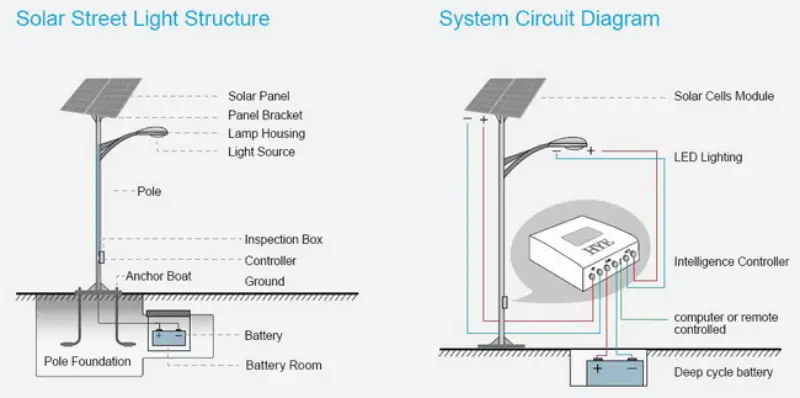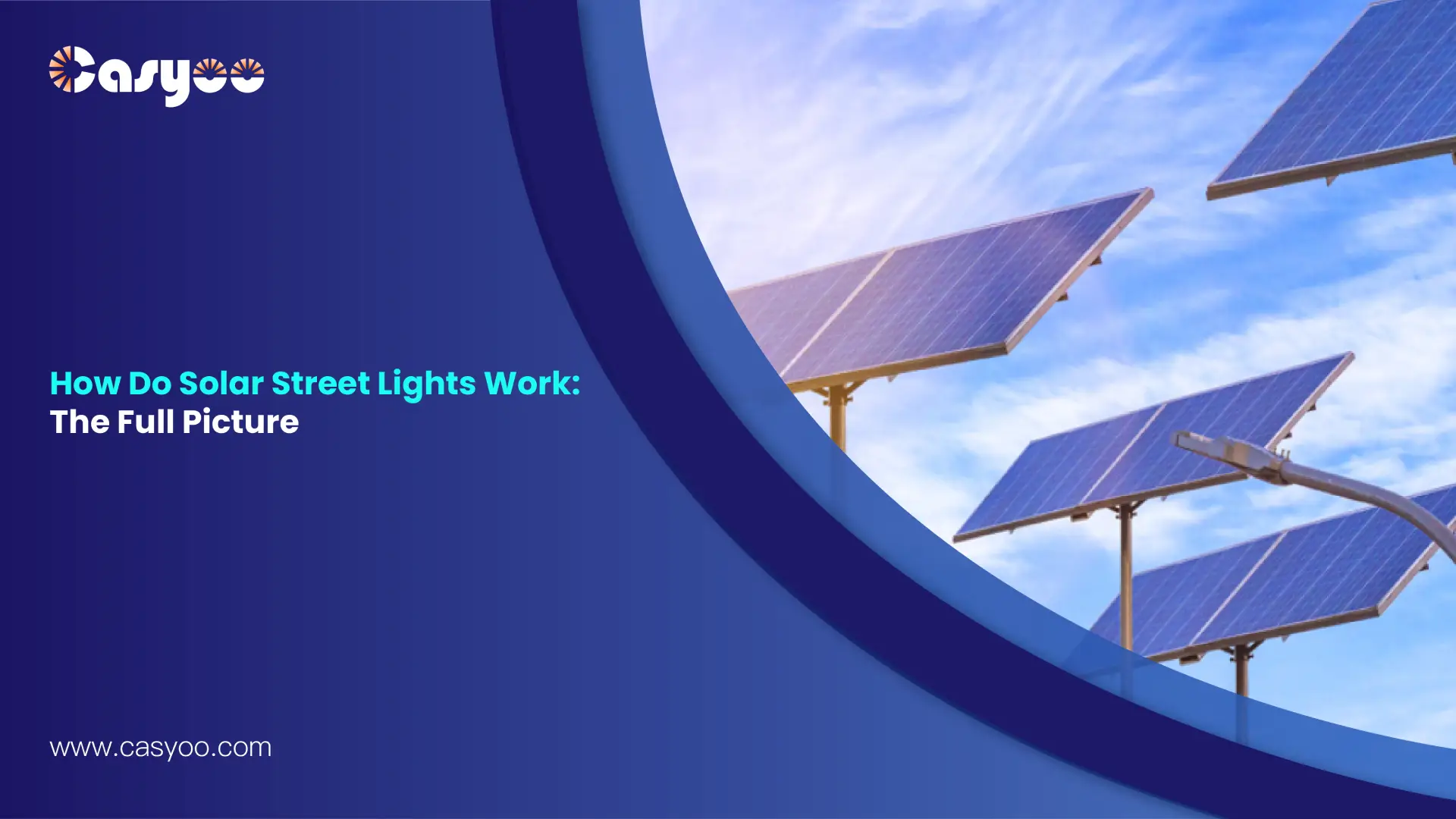Solar street lights, being an emerging lighting technology, typically pique the interest of observers. As an LED engineer with 7 years of expertise, I am regularly asked, “How do these things actually work?”
What interests me the most is that these seemingly basic lights are actually sophisticated systems that use nature’s most abundant energy source. Additionally, they are changing how our cities are lit.
In this complete guide, I’ll use my hands-on experience to explain how solar street lighting function. Whether you’re a city planner, a property manager, or simply interested in sustainable technology, you’ll learn everything you need to know about these incredible lighting systems.
Understanding Solar Street Lights: Basic Principles and Core Components
A solar street light is essentially a self-sustaining power and illumination system that converts solar energy into useful light. During the day, the solar panel absorbs and transforms sunlight into electrical energy, which is then stored in the battery, similar to putting money in a bank account for later usage. The gadget automatically turns on as it becomes dark, using the energy it has stored to power the LED lights. This smooth operation has made current solar street lights not only environmentally benign, but also more dependable and cost-effective than traditional illumination in a wide range of applications.
The Solar Panel: Your Light’s Power Plant
The solar panel is composed of numerous thin layers of unique materials pushed together, much like a piece of’magic glass’ that can ‘digest’ sunlight. Each layer serves a specific purpose: the top layer receives sunlight, the middle layer transforms it into electricity, and the bottom layer stores this electrical energy. Modern panels are remarkably versatile, producing power even under less-than-ideal situations. While direct sunshine is ideal for charging, these modern devices may still catch up to 25% of their regular capacity in gloomy conditions. Recent developments in semiconductor technology have resulted in bifacial solar panels that may capture reflected light from below, increasing energy collection by up to 30% under optimal conditions.
The Battery: Your Energy Storage Bank
The battery system acts as a key energy reserve for solar street lights, ensuring consistent operation at night and during periods of inadequate sunlight. Modern systems typically use one of two types of batteries, each with unique advantages. Although they weigh less and are more efficient, lithium-ion batteries are more expensive initially. Gel cell deep cycle batteries, while heavier, perform better in severe temperature environments. These complex storage systems can operate for up to 5 days in adverse weather conditions, enabling the autonomous operation required for dependable street lighting in places with variable weather patterns.
The LED System: Where Efficiency Meets Illumination
The LED lighting system is the product of years of lighting technological advancements. Modern LED installations are extremely efficient, converting over 90% of their energy intake into light – in stark contrast to older bulbs, which squander up to 80% of their energy as heat. This efficiency translates into practical benefits: a single LED fixture can last up to 50,000 hours, or roughly 12 years of nighttime operation. Furthermore, these systems produce improved light quality, with color temperatures ranging from 4000K to 6500K, closely matching natural daylight and providing safer, more comfortable illumination for both walkers and drivers.
The Smart Controller: The Brain of the Operation
The controller serves as the system’s primary intellect, coordinating the intricate interplay of energy collection, storage, and utilization. This intelligent component continuously checks battery charge levels, regulates charging cycles, and optimizes light output in response to ambient circumstances. Modern controllers use powerful algorithms to optimize system efficiency, automatically altering brightness based on a variety of criteria such as time of day, battery charge status, detected motion, and ambient light levels. This clever management assures peak performance while extending battery life and system longevity.

Smart Operation Features: Beyond Basic Lighting
Today’s solar streetlights are significantly more clever than their predecessors. Advanced sensors and control systems collaborate to develop adaptable lighting solutions that improve efficiency and effectiveness.
Automatic Control Mechanisms
The heart of this intelligence is sophisticated light sensor technology. As nightfall approaches, ambient light sensors detect a decrease in natural light levels. When these levels fall below a predetermined threshold, usually about 30 lux, the system automatically turns on the LED lights.
However, the main innovation comes from motion detection integration. Modern systems can reduce to 30% brightness when no activity is detected and rapidly brighten to 100% when someone approaches. This smart feature can increase battery life by up to 40%.
Adaptive Lighting Schedules
Time-based dimming increases efficiency even further. Consider this scenario: during the early evening hours, when foot traffic is strong, the lights are turned on full brightness. The gadget automatically modifies its output as the night wears on and activity levels decline.
A typical timetable could look like this: The brightness is set to 100% during peak evening hours (6-9 PM), 50% throughout mid-night, and 30% in the early morning. This dynamic adjustment provides appropriate lighting when needed while conserving energy during low-activity hours.
Remote monitoring tools provide an extra level of sophistication. Cloud-based interfaces enable system managers to monitor performance, alter settings, and even foresee maintenance needs. It’s similar to having a virtual control room for every networked street light.
Environmental Adaptability
Environmental circumstances have a considerable impact on solar street light performance. Modern systems are built to withstand a variety of weather conditions thanks to adaptive charging algorithms and sturdy weatherproofing.
During prolonged periods of cloudy weather, sophisticated controllers automatically activate energy-saving modes. They could lower the brightness or alter the motion detection sensitivity to ensure the device keeps working. These systems can even use historical weather trends to improve their energy management tactics.
Geographic location is also an important consideration in system design. Solar street lights installed in northern latitudes, for example, require larger solar panels and higher-capacity batteries to compensate for the shorter winter days. Tropical systems, on the other hand, require improved heat dissipation features in order to work well.
Real-World Applications and Benefits
Solar street lights offer significant advantages in both urban and distant settings, as proven by real-world examples. A significant example is the Sultan Qaboos University case study in Oman, where LED solar street lights were tested for a 3.4-kilometer main road with 116 lighting poles. The project produced impressive efficiency benefits, with energy usage reduced by 75% compared to typical High Pressure Sodium (HPS) bulbs. These systems prove especially useful in:
- Areas with high solar exposure – Oman’s case study used 5 hours of daily solar charging to power 10 hours of nighttime operations.
- Locations seeking infrastructure efficiency – The study found that grid connection costs were completely eliminated, and transformer loading was lowered.
- Regions prioritizing maintenance reduction – LED lifespans topped 50,000 hours, compared to 5,000 for HPS lights.
- Environmentally conscious zones – In comparison to identical HPS illumination, the LED system reduced annual greenhouse gas emissions by almost 40%.
Real-world data indicated that, despite greater initial costs, solar LED systems achieved a full return on investment after 3.5 years due to energy and maintenance savings. In the university case study, annual power usage decreased from 169,360 kWh to 42,340 kWh, resulting in cost savings of $8,800 to $2,200 per year while maintaining required lighting levels.
Future Developments: The Road Ahead
The future of solar street lighting appears to be surprisingly bright. Integration with smart city infrastructure is already underway, enabling lights to function as nodes in broader urban management systems. Today, more recent iterations of “smart poles” include air quality monitors, security cameras, and weather sensors. Some systems even support electric vehicle charging, transforming ordinary light poles into multi-purpose urban service stations.
These systems are changing as a result of the Internet of Things (IoT). Consider street lights that can interact with one another, altering their output based on traffic patterns, weather conditions, or special occasions. This kind of intelligent coordination is currently being tested in numerous large cities.
Conclusion: Lighting the Way Forward
Solar street lighting is a game changer in urban infrastructure, combining sophisticated technology with sustainable practices. As we’ve shown in this passage, these systems have numerous advantages, ranging from smart operation and adaptive controls to major cost savings and environmental benefits. The real-world implementations, particularly at Sultan Qaboos University, show how solar street lighting may reduce energy usage by 75% while maintaining high illumination quality.
Casyoo specializes in specialized solar street lighting that is both efficient and reliable. Our industry-leading systems include sophisticated controls, remote monitoring, and extensive support. To arrange a free lighting consultation, get in touch with our technical staff right now. Allow us to help you build a more promising and sustainable future.




